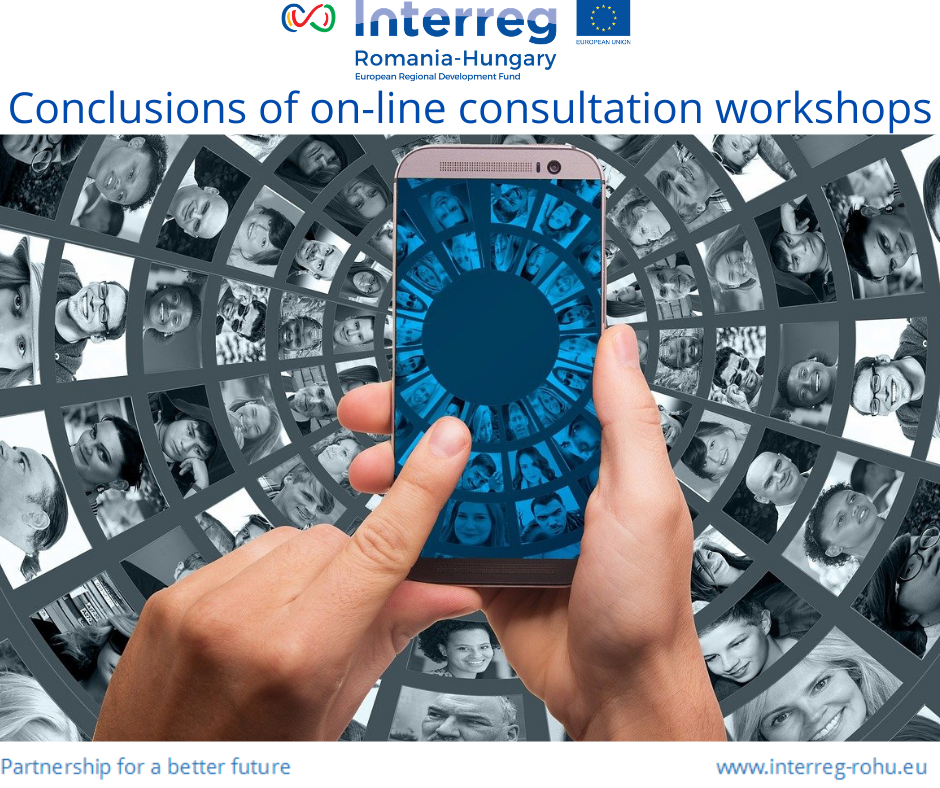


Between 19 - 23 October 2020, a series of 6 on-line consultation workshops have been organized, in the context of finalizing the Territorial Analysis, a strategic document elaborated under the programming process related to the future Interreg Programme between Romania and Hungary (2021-2027).
More than 160 participants, representing local and regional authorities, public institutions and NGOs from the 8 counties of the Programme area, as well as relevant central authorities in both partner countries, acting in different fields, like public administration, environmental protection, transport, education, healthcare, economic and academic environment and others, attended to these workshops.
During the events, valuable qualitative information and knowledge have been shared between participants and programming experts, contributing thus to a more comprehensive image of the real needs in the Programme area. The high qualified experts presented the main findings of a complex process of analysing statistical data (mainly European sources, but also national statistics) and existing local/regional/national strategies. Also, the main cross-crossing strengths, weaknesses, opportunities and threats have been identified with the help of more than 120 indicators and further structured in relation to each of the 5 Policy Objectives proposed by the new EU regulatory framework. Nevertheless, even if based on a considerable volume of data, the Territorial Analysis has to be completed with inputs from the “real-life”, by an in-depth local data analysis in order to identify the common real threats, the obstacles hindering the cross-border cooperation and finding the best solutions to bridge the existing gaps, to jointly overcome the challenges. This was, in fact, the main purpose of these consultation workshops.
Furthermore, both the programming experts and participants attending the workshops underlined the importance of designing a cooperation programme having not only a strong cross-border character but which also develops complementarities and synergies with other programmes/funding opportunities in the area.
Besides the information gathered during the workshops, participants have been invited to submit all relevant data available at local/regional and even national level, any recently updated strategy and to share the future directions of development envisaged at institutional level.
The fruitful discussions highlighted several common priorities for the future Programme. Handling waste management (circular economy, renewable energy) and joint risk management (climate changes, floods, earthquakes), joint management of protected areas and riparian zones are some of the directions identified by both partner countries as of outmost importance, to be addressed under Policy Objective 2 – a greener Europe.
Better healthcare infrastructure and services, inclusion of disadvantaged categories, depopulation phenomenon, education are important domains which, considering also the actual Covid-19 crisis and the considerable impact thereof, not only on the targeted area, but also at European Union level, have to be considered as first priorities, under Policy Objective 4 – a more social Europe. Despite the high potential in the Programme area in what concerns the cultural heritage and touristic attractions, the correlation between Programme and projects indicators seems to be difficult. Moreover, in the actual and most probably near future context, several obstacles in terms of impact and sustainability of such initiatives have to be overcome.
The presence of important university centres in the area, on both sides of the border, as well as the growing of Foreign Direct Investments, represent an important potential for research and innovation, for ICT and digitization initiatives, under Policy Objective 1 – a smarter Europe.
As regards connectivity in the context of Policy Objective 3 – a more connected Europe, the main obstacles identified were the deficient railway network in the area and different status in relation to Schengen of the 2 partner countries. However, developing cross-border public services and digital networks are considered good opportunities for cooperation.
Opportunities and threats that could be tackled under Policy Objective 5 - a Europe closer to citizens have been also presented and briefly discussed, with focus on the real needs existing on both sides of the border and on the possibility to jointly address such needs.
High interest in both Interreg Specific Objectives (ISOs) was expressed by participants and even one strategic project idea was mentioned. ISO1-a better Interreg governance, having a wider addressability as compared with ISO2- a safer Europe, represents a great opportunity to increase the institutional capacity of and cooperation between local stakeholders, to complement the lack of statistical data by developing common databases. Also, relevant national stakeholders could cooperate for identifying possible solution to the legal and administrative obstacles.
All relevant inputs and information gathered within the workshops, as well as further made available to the programming experts, will be integrated in the final version of the Territorial Analysis for a coherent and comprehensive document, based on which the future cooperation programme is to be developed.
